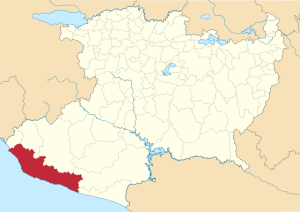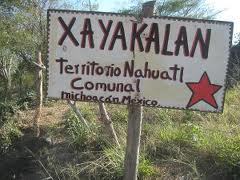The community recuperation of Xayakalan on the Michoacán Coast is about their lands, guards and autonomy
Source in English: Chiapas Support Committee Blog
All kinds of interests cross each other within their territory: the governments seek to implement highway projects that facilitate the shipment of merchandise and stimulate tourism at the beaches; the mining companies want to exploit the vein that originates in San Miguel de Aquila; the small property owners want to plant their lands or subdivide and sell them; and, the drug traffickers have and important point for circulation of their merchandise here.
By: Adazahira Chávez
Organization of the Nahua community of Santa María Ostula, Michoacán, in its struggle for land, was renewed in February of this year. Later, in June 2009, the comuneros activated their Policía Community Police and took back the place known as La Canaguancera (renamed Xayakalan). They confronted a wave of murders and disappearances —especially against members of the traditional guard of of the communal wealth (commission)— that established a climate of terror and obliged the displacement of entire families.
But they are returning now and, as they declared in 2009, assert that they will not abandon their lands. Recently, accompanied by self-defense groups from Tierra Caliente, the community guards re-entered their territory —many of them, like their commander Semeí Verdía, were exiled— and the displaced comuneros also returned to Xayakalan, which continues in a legal dispute with the small property owners of La Placita, who invaded it four decades ago. The urgent task, they point out, is to construct anew the assemblies and to work the lands that gave them sustenance and that they had to abandon.
The task does not look easy, and the Nahuas know it. They tell that all kinds of interests cross each other within their territory: the governments seek to implement highway projects that will facilitate the shipment of merchandise and stimulate beach tourism; the mining companies want to exploit the vein that is born from San Miguel Aquila; the small property owners want to plant their lands or subdivide and sell them; and the drug traffickers have an important circulation point here for their merchandise. In this state —according to the denunciations that the comuneros have made for years— many times these actors are the same subjects. And the comuneros of Ostula are the owners of this coveted land.
Rich land, dispossessed [stolen] land
The communal capital de Ostula and its 22 administrative districts encompass more than 28,000 hectares (approximately 69,000 acres) of Aquila Municipality, one of those of greatest marginalization in Michoacán. The Nahuas have populated the portion of their territory that extends to the Michoacán Coast little by little.
The lands corresponding to the district of Xayakalan, the comuneros report, are located inside of their land titles that in the 18th Century were the very first and also inside of the Presidential Resolution that recognized part of its territory in 1964. Despite that, they confront agrarian litigation over some 700 hectares that six small property owners of La Placita invaded “not only for the planting of papaya, mango and tamarind, but also to sell it to the highest bidder” in spite of precautionary measures in favor of the indigenous. The Commission for the Defense of the Communal Wealth of Ostula points out that some of those invaders are heads of organized crime in the region.
Aquila’s land has an abundance of minerals (silver, zinc, gold and copper), besides iron deposits, which the Ternium, Sicartsa and Metal Steel companies currently exploit, and it contributes one fourth of the national production. The vein that runs through San Miguel Aquila —a community from which members of the traditional guard and the comuneros also had to leave due to conflicts with the mine and with organized crime— arrives in the lands of Ostula, and the Argentine company Ternium has in sight its future exploitation. Ternium is the owner of half of Peña Colorada, the mine in Ayotitlán, Jalisco, which has also provoked persecutions against leaders of the Nahua comuneros like Gaudencio Mancilla.
Inside of this invaded territory pass not only the rich mineral veins, but there are also beaches with animal species in danger of extinction. There, they contemplate the expansion of the Coahuayana-Lázaro Cárdenas Highway, and even the construction of a port for transporting the materials that Ternium extracts from San Miguel Aquila.
On June 13 and 14, 2009, the National Indigenous Congress published the Ostula Manifesto, which vindicated the right to self-defense. After several fruitless attempts at negotiation and upon feeling mocked by the government, the comuneros took back the lands of Xayakalan in 2009, established their community guard “to care for the territory that belongs to us” and around 250 people, belonging to 40 families, settled here.
Los comuneros decided not to participate in the 2011 official (national) elections, just like their Purépecha brothers of Cherán, Pómaro and Coíre, in rejection of the authorities’ lack of efficiency and the divisionism that, they denounced, the political parties promote.
The response to their challenge was deafening. In the last three years, 32 residents of Ostula were brutally murdered or disappeared. The executions in 2011 of the leaders Trinidad de la Cruz Crisóstomo, known as don Trino or el Trompas, in charge of the community guard, and of Pedro Leyva stand out. The Navy bases —that were established after 2009— did not help to stop the wave of violence. Judicial authorities did not resolve even one single crime. Bullets from the “goat horns” (AK- 47s) populated the crime scenes, and the threatened families fled.
Few residents stayed in Xayakalan, but those displaced occupied themselves with planning their return and the reconstitution of their autonomous organization, which was concretized this 2014. On February 8, “a group of comuneros of Santa María Ostula, in coordination with self-defense groups from the municipalities of Coalcomán, Chinicuila and from the capital of Aquila, took control of the tenancy of Ostula,” they reported in a public document.
Coincidentally, since that day “groups of federal ministerial police and members from the public ministry, in a totally illegal way, have been threatening the comuneros that live in Xayakalan with evicting them.” For the indigenous it is “the continuation of the grave conditions of an undeclared war that Ostula has lived through precisely since it resolved to guard the lands of Xayakalan, on June 29, 2009.”
This February 10, a federal Army platoon attempted to disarm the community guard and the self-defense groups that were supporting them, but residents made the soldiers return the weapons. On February 13, more than 1200 comuneros in an assembly decided to formally reorganize the Community Police. Now, efforts are centered on strengthening community decision mechanisms, reconstructing the material base for their organization and survival —food and scarce resources— and on maintaining security within their territory. Despite the years of terror, they indicate to Ojarasca from Ostula, “the people respond to their ancestral organization.”
——————————————————–
Originally Published in Spanish by Ojarasca #203
La Jornada Supplement, March 2014
Translation: Chiapas Support Committee
En español: http://www.jornada.unam.mx/2014/03/08/oja-costa.html






